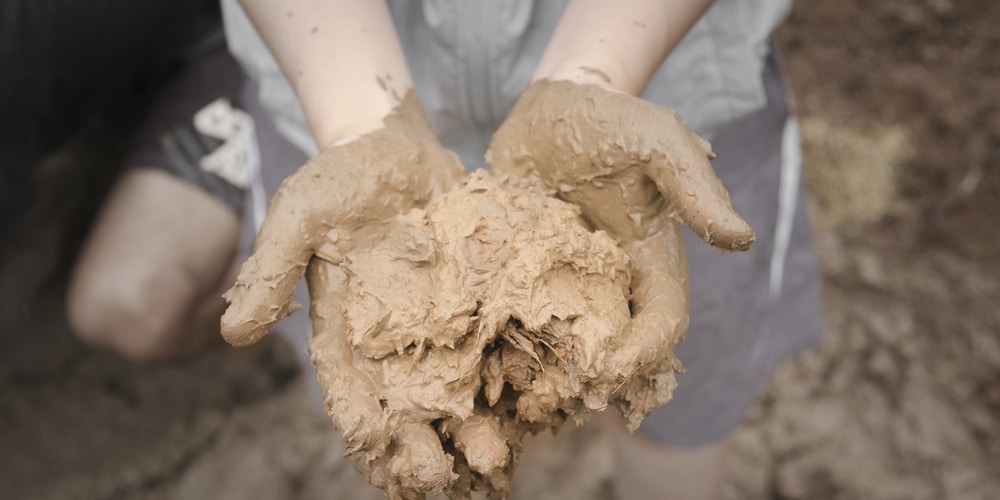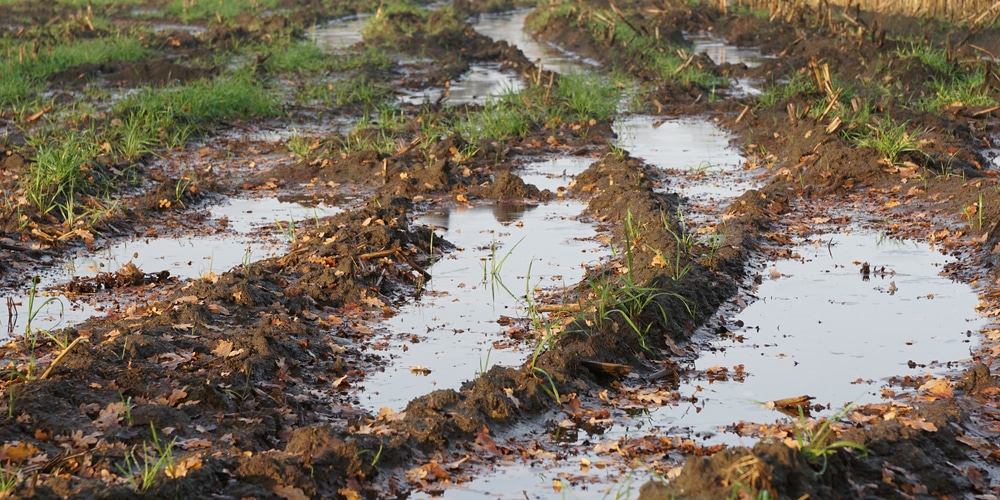Water moves very slowly downward through clay soil because it has tiny pores that attract water more than other types of soils with large pores. The small pores make water move slower in clay than in sand particles with bigger pores. This type of soil holds water for a long time and drains poorly.
What Happens When Clay Soil Gets Saturated?

When clay soil gets saturated, it becomes sticky. It is hard to work on such soil, especially in a garden. The small particles swell due to excess moisture and drain slowly. Besides that, it feels like plasticine until the moves downward throughout it. Generally, it takes an hour for the water to move a quarter-inch down clay soil. So expect the water to remain at the top for long after heavy rainfall.
Tips for Managing Clay Soil
Wet clay soil is not manageable, so you have to wait until it dries up. This takes about three days after irrigation or rainfall. The moderately dry clay soil is easy to break with a garden fork or a spade. If the soil is sticky, it means water has not drained completely. On the other hand, if it is too hard to till, you have to pour some water on it and wait until it dries to the perfect point for tilling. Dry clay is too hard to till or even handle.
The best way to irrigate clay soil is head sprinklers. However, stop irrigating once the water starts running off. An irrigation system with a timer is the best to avoid water overflow. Since this soil retains water for too long, it can suffocate your plants’ roots when there is too much water. Allow the soil to dry until it’s slightly moist before you can water again. Allowing water to drain also gives the plants’ roots to breathe.
Clay soil is a big water reservoir, but it also has plenty of nutrients for plants. Water cannot wash away the nutrients because they adhere to the sticky clay particles. However, plants access nutrients, and there is no need to add fertilizers like in gardens with light soils.
How to Improve Clay Soil
The soil’s structure determines its porosity. However, you can change the structure of clay soil to increase its porosity. This changes how the soil particles aggregate. You can enrich clay soil with humus to reduce stickiness when wet. When humus is added, clay becomes less sticky, forms soil crumbs, and has more cohesiveness. It allows air circulation and holds plenty of water, making the soil drain fast and plant nutrients.
Adding some well-rotted manure, leaf mold, or compost material, including composted dust and grape pomace or cottonseed meal, enhances clay soil. The decomposing matter is the best option and quickly changes clay soil structure. Keep adding organic matter into the soil and clay soil structure to accumulate the improvement as years go by.
Is it important to aerate clay soil?
While it’s not a must you aerate clay soil in your garden, it doesn’t hurt to do so. It enhances the soil’s drainage. It also benefits plants by allowing water to drain away fast while creating a good environment for air circulation. Aerators create pores that lack in clay soils. It helps water to move down faster after irrigation or rainfall. However, do not aerate your garden too often; it should be once or twice a year.
How to make clay soil better for gardening
It is possible if you want to balance your garden’s clay soil. Start by getting some sandy soil and mixing it with organic material. Some organic materials you can use include manure, compost, or peat moss to create soil that can be used to grow plants.
Why Does Water Move Very Slowly Downward Through Clay Soil: Final thoughts
The best soil for farming or growing plants is loam soil. It is a mixture of different soil types, including sandy and clay soils. Loam soil should have about 40% silt, 20% clay, and 40% silt. This means less clay, so it’s not easy to change 100% clay soil into loam soil. However, adding organic matter regularly and aerating clay soil improves its quality. This will not create loam soil, but you can use it to grow plants.
Related Article: Is Loam the Same as Topsoil

